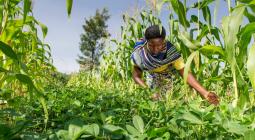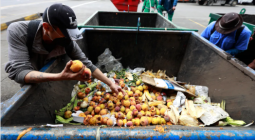WHAT IS THE SOLUTION TO NIGERIA’S FOOD CRISIS?
Nigeria, Africa’s most populous nation and largest economy is facing a serious threat of food insecurity and malnutrition that could affect millions of its citizens this year. According to the World Bank’s latest Food Security report, seven states across the northwest and northeast regions are projected to be at crisis food security level in 2024, mostly because of persistent insecurity and armed conflict that have disrupted farming activities and livelihoods. The states are Borno, Adamawa, Kaduna, Katsina, Yobe, Sokoto, and Zamfara. Areas such as Abadam, Bama, Guzamala, and Marte, are expected to experience emergency food security levels, as a result of limited household food stock and access to market and humanitarian aid. Currently, these areas already suffer from a large-scale humanitarian crisis, where 8.3 million people need assistance. Without immediate action, the number of people suffering from acute malnutrition in the affected states would increase. How can Nigeria address this looming food crisis and ensure food security and nutrition for all Nigerians?
How did Nigeria end up with a food crisis?
Before this news, the food security situation in these predestined states has been precarious and deteriorating. Over the years, all seven states have witnessed increasing violence and banditry, consequently leading to crop losses, livestock theft, and the killing of hundreds of farmers. Borno, Adamawa, and Yobe states have been affected by the Boko Haram insurgency and the Lake Chad Basin crisis, which has disrupted livelihoods. According to the 2021 Cadre Harmonisé analysis (a regional framework for assessing the current and projected food and nutrition security situations in the Sahel and West Africa), about 12.9 million people in 21 states of Nigeria – including the seven states mentioned – were experiencing acute food insecurity from October–December 2021, an increase of 77 percent compared to the same period in 2020 when 7.3 million people were in high acute food insecurity. The report placed these states in IPC Phase 3 or above, a severe situation where people face crisis, emergency, or famine levels of food insecurity.
In the last four years, the food security situation in Nigeria has been further worsened by the rising food prices and inflation, which have eroded the purchasing power of many households. The latest CPI report from the National Bureau of Statistics (NBS) puts food inflation at over 33%, the highest in about two decades. Moreover, since the 2020 COVID-19 pandemic, approximately 78% of Africans have been unable to afford a nutritious diet. Beyond the aforementioned states, the Food and Agricultural Organisation (FAO) reported that around 5 million Nigerians are at risk of hunger in 2024.
Last July, President Tinubu declared an emergency on food insecurity in the country and moved the item to the National Security Council. However, the move has resulted in little or no impact as food prices continue to surge. Last week, a revolt erupted in Niger state due to soaring food prices and starvation in the state. As a temporary response to the nation’s growing food crisis and the rising cost of commodities, President Bola Tinubu ordered the immediate release of more than 102,000 metric tons of various grain types from the National Food Reserve and the Rice Millers Association of Nigeria. What is the best way to ensure a lasting impact?
Sustainable food systems in the face of crisis
To prevent a food crisis, many countries have adopted various measures to address the specific challenges they face. 2016, Colombia faced a food crisis when a prolonged drought and violent conflict affected food production and access. Colombia first signed a peace agreement that ended the armed conflict between the Government of Colombia and the Revolutionary Armed Forces of Colombia (FARC). The agreement seeks to address the root causes of the conflict and improve food security. Next, they enacted the National Food and Nutrition Security Policy. It was a policy that involved the participation and coordination of multiple sectors and stakeholders, such as agriculture, health, education, social protection, and civil society. The government also launched a national initiative called The Zero Hunger Pact. The initiative mobilized resources and partnerships from the public and private sectors, as well as international cooperation. According to the World Bank, Colombia’s poverty rate declined from 28.5% in 2016 to 17.5% in 2019. Colombia’s undernourishment rate dropped from 8.1% between 2014-2016 to 6.4% between 2017-2019.
One of the common solutions for countries facing food crises is to support family farming, which is a type of agriculture that depends on family labour and management. Family farming is considered important because it preserves traditional food products while contributing to a balanced diet, safeguards the world’s agro-biodiversity and the sustainable use of natural resources, and resilience for small-scale producers, especially in countries with growing populations. An average small family farm in Tanzania generates a gross income of about $5,032 per year, whereby the majority is acquired through on-farm activities, about 56%, through the growing and selling of crops.
However, addressing the soaring prices of food items might need a more innovative approach because it transcends food inflation. For example, in 2020, India introduced a minimum support price (MSP) for 22 crops, which is the price at which the government will buy crops from farmers. This helped to stabilize prices while providing farmers with a guaranteed income. The Nigerian government is already taking steps to address rising food prices, such as releasing food from strategic reserves and cracking down on food hoarding. However, there is no one-size-fits-all solution to rising food prices. The food security and nutrition situation in Nigeria is urgent, and concerning and requires full-scale intervention. Preventing a food crisis would require a combination of measures that address the diverse and complex factors that affect food security.
Cover photo: By VENTURES




